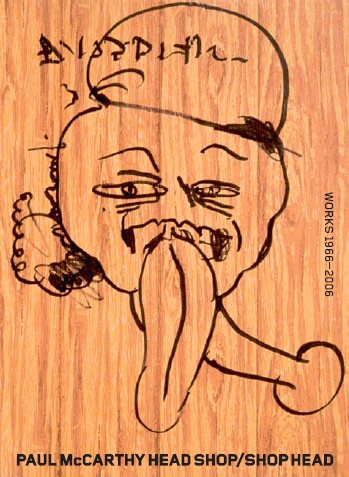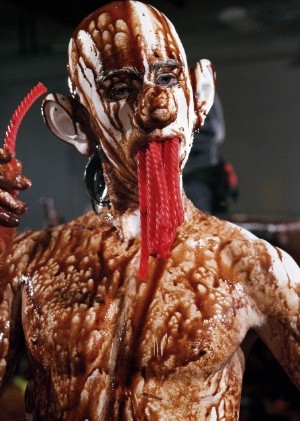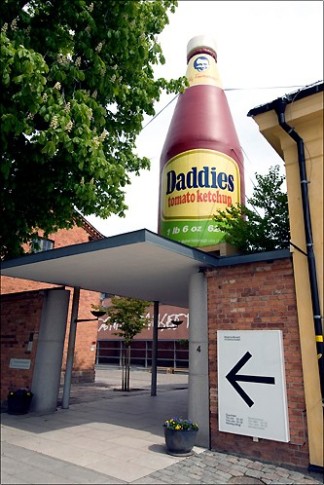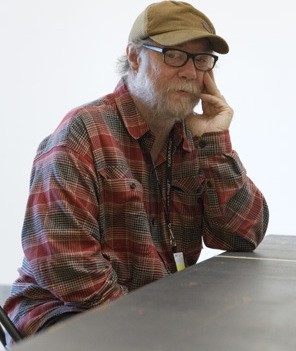
Catalogue
In his essay, Thomas McEvilley reviews Paul McCarthy’s films and progress from the early 1970s to the present day, dividing his development into four stages. The first of these he calls the “structural phase”. The early films do not incorporate a narrative but consist of the artist’s monotonous movements to attain a kind of primordial state. The artist’s abundant use of body fluids and other liquids is also associated with the early mythological stages of humanity, as well as with the foetus surrounded by fluid. Subsequently, McCarthy moves on to a “ritualistic phase”, inspired by ancient death and fertility rites. But, as McEvilley points out, the “blood sacrifice” in McCarthy’s works is merely Heinz ketchup.
In the third phase that McEvilley identifies, another character appears, as yet enacted by McCarthy, but transformed into what McEvilley calls the “Sacred Clown”, an archetype that appears in pre-colonial America. The films in the fourth phase relate more to the real world and popular culture than to rites and introspection. At this point, McCarthy is no longer an actor in his own films but operates as a Hollywood director. McEvilley also clarifies in his essay how McCarthy’s film imagery develops towards increasingly sophisticated visual techniques.
Iwona Blazwick writes about Paul McCarthy’s sculptures and masks. The latter, she claims, are associated with tribal rituals where the individual forsakes his identity. All McCarthy’s works involving masks suggest a role reversal, according to Iwona Blazwick. The actors become a form of cameras that edit, crop and captivate the onlookers. In McCarthy’s works sacred symbolic figures, such as those in the classical Greek drama, are replaced by Madonna, Pinocchio or George Bush. The entertainment industry, multinational corporations and politics depend on cult figures, such as celebrities and comic strip characters, in order to operate. Thanks to the mass media and information technology, these idols are recognisable throughout the world. McCarthy mixes the idol images up and affixes them to male and female bodies. He reveals them as interchangeable, ephemeral signs for a deeply-rooted ideology based on consumerism and political passivity.
When McCarthy has discarded his mask it often ends up among other performance props and is converted into a sculptural object. Objects symbolise lust and death. Some objects are equipped with genitals and all are splattered with some fluid, ketchup or chocolate sauce, that resembles blood or excrement. Unlike his shabby, down-scaled props, scattered on a table or stage floor, McCarthy moved on in the 1990s to make figures and heads, most of which are pure and over-sized, such as Spaghetti Man and Tomato Heads. Like the “cute” Disney characters, their heads are disproportionately large in relation to their bodies, but they are nearly always blind or have detachable eyes, and the dreamlike, eerie quality arouses both delight and terror. As Blazwick points out, they imitate the over-refined surfaces of American corporate culture.
The catalogue cost SEK 380 (normal retail price after the exhibition: SEK 450).
Foreword by Lars Nittve, Director
The physical formalism of minimalism, or the exuberant materialism of pop art? Comic performance or existential actionism?
More or less? In jest or in dead earnest? Criticism or acceptance? Sadism or love?
Drawing? Sculpture? Film? Photography? Performance?
Eleven question marks to start a foreword – how convincing is that? Entirely convincing, hopefully – just like Paul McCarthy’s work. Convincing with regard to the magnificence of the quagmire, the key role of shifts, overlapping and fundamental instability in contemporary art. About the power of uncompromising uncertainty.
For 40 years now, Paul McCarthy has been searching out the points where isms, genres, tastes, influences and strategies intersect. All, apparently, with the overall aim of producing an unequivocal picture of life in the West. Both a general “West” – the Western World – and a more specific one, the American west coast, spelled Hollywood.
Paul McCarthy is emerging as one of the most seminal artists of recent decades. It is with great pride, therefore, that we note that Moderna Museet will be the first museum to feature a full-scale retrospective of what the exhibition curator Magnus af Petersens calls “40 years of hard work”. But is this purely a coincidence? Ever since the days when Swedish emigrants wrote letters home from America, Swedish culture has been quick to pick up on American influences – and Moderna Museet’s own past is intimately associated with American art, not least with its tawdry symbiosis with popular culture.
Head Shop/Shop Head, as the exhibition is called, was created in a close collaboration between Magnus af Petersens, curator at Moderna Museet, and the artist and his team, of which his wife Karen McCarthy, his son Damon McCarthy, Kate Costello and Ann-Marie Rounkle are the key members. When it comes to a major project such as this, it is worth remembering the sacrifices an artist makes for us, the audience. Over the past three years, many months have been devoted to discussing the selection of works, the plans for the installation and the contents of the catalogue. Months that could otherwise have been filled with artistic work. I can only express my humble gratitude to Paul McCarthy for his generosity and say that we have done our best to reciprocate it. Thanks, also, to Magnus af Petersens, who, despite his many other duties at Moderna Museet, combined a clear inner vision with a receptiveness to the artist, in steering what may be the museum’s largest exhibition ever, so steadily towards completion.
As always, we are indebted to many people in connection with a gigantic project like this, but I will limit myself to thanking the lenders who have generously put works at the disposal of not only Moderna Museet but also Aros in Aarhus, Denmark, where they will be shown after the exhibition in Stockholm. Paul McCarthy’s works undoubtedly leave huge voids in any collection when they are lent out. And finally, special thanks to Paul McCarthy’s gallery, Hauser & Wirth – Iwan and Manuela Wirth, Ursula Hauser and Marc Payot as well as Lawrence Luhring and Roland Augustine from his New York gallery Luhring Augustine, who supported the project from the very start.
Welcome in to the Head Shop/Shop Head!
Lars Nittve
Director



